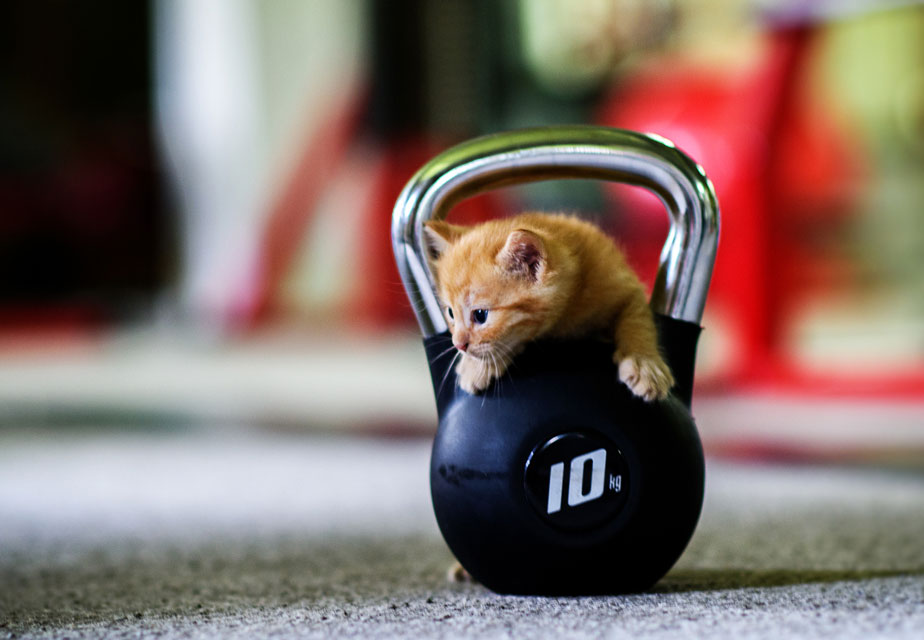Kitty Boot-Camp: A Workout Plan for Your Cat

It's a new year, and many people are incorporating changes to their diet and exercise plans into their daily routine to make reasonable changes in their lives. Does your cat need to get on a health plan too?
Consult a Veterinarian First
When you're considering a new health plan for your cat, the first thing to do is check with your veterinarian. There are a few things you'll need to know from the doctor before you proceed:
- Is my cat overweight? While you can start to get an idea about this at home, your vet is best suited to determine whether your cat is overweight and, if so, by how much.
-
What food should my cat eat and how much? Life stage influences the type of diet your cat needs (kitten, adult, or senior), as does their lifestyle (highly active or mostly sedentary) and any medical problems they have. Get a food recommendation from your vet and find out how much the doctor recommends daily, based on calorie requirements for weight maintenance or loss, depending on what your cat needs.
- Is my cat healthy enough for an exercise program? Let your vet know you're planning to increase your cat's exercise and make sure the doctor believes your cat is healthy enough for that.
Once your vet signs off on your cat getting more exercise, you can get to work making it happen.
Increase Your Cat's Daily Movement
Some indoor cats tend to lie around a lot and aren't inclined to create their own exercise routine, especially once they're out of the kitten stage. That means you may have to encourage that extra movement to get them going. Here are some ways to increase your cat's daily activity:
- Provide catnip or honeysuckle in the form of spraying the toys, catnip or honeysuckle-stuffed toys, or, in the case of catnip, fresh leaves.
- Get lots of throwable, battable cat toys of different varieties. Put some away and then rotate them every so often, so your kitty doesn't get bored with them.
- Stock up on wand toys. These are only to be used under supervision because they can be dangerous strangulation hazards if your kitty tries to play with them alone. But they are fantastic for encouraging your cat to exercise because it stimulates the natural hunting instinct all felines have. Set aside at least 10 minutes a day to get a wand toy out and play interactively with your cat, encouraging maximum movement.
- Leave out things that tend to spark cats' play instincts, like paper bags with the handles cut off for safety, cardboard boxes, and ball toys. DO NOT leave out any ribbon, string, or yarn, which dangerous both due to potential strangulation and because cats may ingest it and suffer life-threatening GI obstruction.
- Consider an automatic cat toy that can run when you aren't around to play with your cat.
- Encourage your cat to climb by getting a tall scratching post or a cat tree.
- Get a food puzzle for your cat and put part of his daily food allotment inside. That will allow him to work for his food, which is good for his mental and physical health.
- Engage in regular cat training. Teaching your cat tricks helps bond the two of you and provides extra exercise for your cat.
- Consider teaching your cat to walk outside on a leash. Learn how to tell if your cat is interested, the rules for walking outside, and step-by-step instructions on how to do the training here: "How to Train Your Cat to Walk on a Leash."
You may consider doing all or some of the above things as part of your cat's exercise boot camp. Pick what you and he will both be able to stick to and make movement and fun a part of your indoor kitty's daily routine.
You May Also Like These Articles:
Obesity in Cats: Overview of Dangers and Solutions
Hands-On Guide to Checking if Your Cat Is at a Good Weight
How Do I Feed My Overweight Cat
Cat Weight Loss: How You Can Help Your Cat Lose Weight
Notice: Ask-a-Vet is an affiliated service for those who wish to speak with a veterinary professional about their pet's specific condition. Initially, a bot will ask questions to determine the general nature of your concern. Then, you will be transferred to a human. There is a charge for the service if you choose to connect to a veterinarian. Ask-a-Vet is not manned by the staff or owners of CatHealth.com, and the advice given should not delay or replace a visit to your veterinarian.





